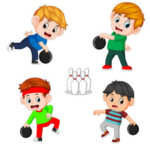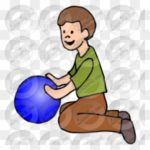
by Neetu | Jun 10, 2020 | Sports
Aim
- Roll the ball on the floor using different speeds and pathways.
- Describe and demonstrate a zigzag pathway.
Equipment Required
4 large cones, 1 basketball per student
Play Area Set-Up
- Create boundaries for a large activity area with cones.
- Students scattered throughout the area in self-space with a ball
Activity Description
- It’s time to work on controlling the ball with our finger pads by playing a game called Walk the Dog.
- Your basketball is a dog and its time to take it out for a walk. Start with your feet shoulder-width apart and the ball on the floor in front of your feet. Using only your finger pads, slowly roll the ball back and forth from left to right, one hand to the other. Can you roll the ball making different shapes? Using different pathways?
KEY TEACHING POINTS – Finger Pad Touches, Slow and Controlled
Grade Level Progression
- Work on rolling the ball in front of the body, improving the transition from hand to hand.
- Begin rolling the ball around the legs, making different patterns (e.g., circles, figure-8s, zigzags).
- Slowly roll the ball throughout the activity area, eyes alert, and making quick looks for other walkers.
Challenges & Modifications
- Pair students and prompt them to take turns mirroring each other’s movements.
- Students roll the ball around their bodies while seated
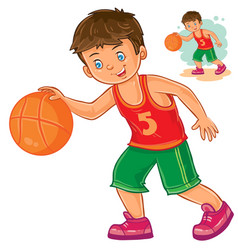
by Neetu | Jun 10, 2020 | Sports
Aim
Ball dribble with one hand while walking in general space.
Equipment Required
4 large cones, 1 basketball per 2 students, 1 spot marker per 2 students
Play Area Set-Up
- Create boundaries for a large activity area with cones.
- Scatter spot markers throughout the area.
- Pair students, scattered throughout the area.
- One student on a spot and the other with a ball.
Activity Description
- The partner with the ball is the driver. The partner on the spot is the driving instructor. When I say, “GO!” the drivers are going to dribble throughout the activity area, working hard not to cause a crash.
- Driving instructors will watch their drivers. On the stop signal, give the driver’s thumbs upgrade if the driver follows the cues we’ve learned in class. (See grade level progressions for specific criterion.)
- After all, drivers have received their grades, switch roles and begin on the start signal
KEY TEACHING POINTS – Dribble with Finger Pads, Waist High, Eyes Alert, Make Quick Looks
Grade Level Progression
- Drivers dribble in self-space (at their spots) with 1 hand and make more than 1 consecutive dribble.
- Drivers dribble continuously in self-space using finger pads.
- Drivers dribble continuously while walking in general space, using finger pads with each dribble waist-high.
Challenges & Modifications
- Prompt students to take a driver’s test dribbling with the non-dominant hand Use foam balls to decrease anxiety and increase student confidence.
- Continue to work on a bounce and catch with students having difficulty dribbling
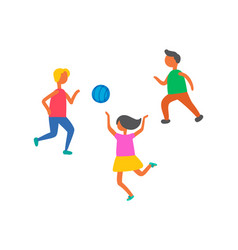
by Neetu | Jun 10, 2020 | Sports
Aim
Demonstrate & develop accuracy while catching (eyes on the ball, fingers apart, catch with hands)
Equipment Required
4 large cones, 1 basketball per student
Play Area Set-Up
- Create boundaries for a large activity area with cones.
- Students scattered throughout the area in self-space with a ball.
Activity Description
- It’s time to Bounce and Catch with an added challenge!
- When I say, “GO!” everyone will begin bouncing and catching their basketballs. While you’re practicing, I’ll be going around to each student and challenging you to catch a ball that I bounce to you.
- Keep practicing until you hear the stop signal.
KEY TEACHING POINTS – Eyes on the Ball, Fingers Apart, Catch with Hands, Show Hands, Eye Contact
Grade Level Progression
- The prompt student to get their hands ready for the ball in order to catch a soft bounce pass.
- Prompt students to “show hands,” working to catch the ball with hands, rather than trapping it against their body.
- Choose a skilled and responsible student to help you make well-thrown bounce passes to fellow students. Prompt those students practicing Bounce and Catch on their own to try and add a clap (or several claps) before each catch.
Challenges & Modifications
- Pair students so they can pass back and forth, working toward a mature bounce pass.
- Use foam balls to decrease anxiety and increase student confidence.
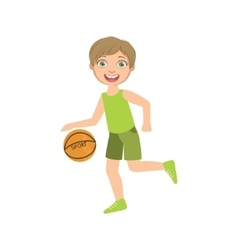
by Neetu | Jun 10, 2020 | Sports
Aim
Understand differences between self-space and general space while moving safely through general space
Equipment Required
4 large cones, 1 basketball per student, 1 bean bag per student
Play Area Set-Up
- Create boundaries for a large activity area with cones.
- Scatter bean bags throughout the activity area.
- Balance a basketball on top of each bean bag.
- Each student standing next to a bean bag and ball.
Activity Description
- It’s time to play 7 Dribbles. Each basketball is perfectly balanced on a bean bag. When I say, “GO!” pick up the ball next to you and dribble it 7 times.
- After 7 dribbles, balance the ball back on the bean bag and then move to a new ball to make 7 more dribbles. Continue until you hear the stop signal
KEY TEACHING POINTS – Dribble with Finger Pads, Waist High, Eyes Alert, Make Quick Looks
Grade Level Progression
- Dribbles do not have to be consecutive. Students can bounce and catch if dribbling is too difficult.
- Dribbles consecutively with the dominant hand.
- Alternate dominant and non-dominant hands with each new basketball
Challenges & Modifications
- Add 7 jumping jacks (or other exercises) after each set of dribbles.
- Decrease the number of dribbles/bounces to 1-6.
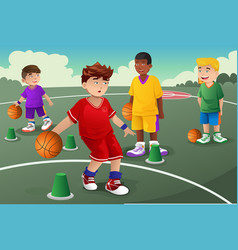
by Neetu | Jun 10, 2020 | Sports
Aim
Every student should make at least 2 dribbles in a row.
Equipment Required
4 large cones, 1 basketball per student
Play Area Set-Up
- Create boundaries for a large activity area with cones.
- Scatter spot markers throughout the area.
- Each student to a spot marker with a ball
Activity Description
- When I say, “GO!” count how many times you can dribble the ball.
- When you make a mistake, complete 1 mini-jump for each dribble that you made (e.g., 4 dribbles in a row = 4 mini-jumps).
- Do mini-jumps by holding the ball in both hands over your head and then making quick 1-inch jumps off of 2 feet.
KEY TEACHING POINTS – Dribble with Finger Pads, Waist High
Grade Level Progression
- Students begin by counting how many times in a row they can drop and successfully catch balls.
- Students count consecutive dribbles in self-space using the dominant hand
- Students count consecutive dribbles as they walk in general space.
Challenges & Modifications
- Add a variety of exercises, working to improve each component of health-related fitness.
- Students can sit with legs spread apart and use a low-bounce foam ball.








